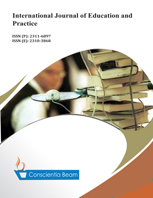Predictors of the Drop in School Marks in Secondary School: Evidence for Effects of Students’ Socio-Demographic Background
DOI:
https://doi.org/10.18488/journal.61.2018.63.147.166Abstract
Referring to the stage environment fit theory (Eccles and Midgley, 1989) we examined whether after the transition from Luxembourgish primary to secondary school students’ school marks would drop. Actually, using latent growth curve modeling it was found that school marks deteriorated in their main school subjects German, French, and mathematics. The drop of school marks was larger in mathematics than in languages. Moreover, the drop of school marks was affected by various socio-demographic variables as the students’ gender, their socio-economic background, and their ethnicity. This finding stimulates the assumption that certain subpopulations of students in Luxembourg receive different support in school, regardless of their academic competences. However, even students’ competences were predictive of the development of their school marks. In the vocational track, high achievers were more likely to drop in school marks than low achievers. We presume that this result indicates a lack of academic challenges in the vocational track, which might eventually hinder better performing students in keeping their initial high achievement level.





